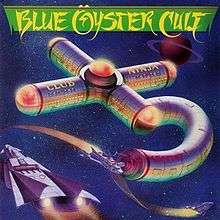Club Ninja
| Club Ninja | ||||
|---|---|---|---|---|
 | ||||
| Studio album by Blue Öyster Cult | ||||
| Released | January 10, 1986 | |||
| Recorded |
Bearsville Studios, Bearsville, New York Boogie Hotel Studios, Port Jefferson, New York Tallysin Studios, Syosset, New York Warehouse Studios, New York City, 1985 | |||
| Genre | Hard rock, heavy metal | |||
| Length | 44:26 | |||
| Label | Columbia | |||
| Producer | Sandy Pearlman | |||
| Blue Öyster Cult chronology | ||||
| ||||
| Singles from Club Ninja | ||||
|
||||
Club Ninja is the tenth studio album by the American hard rock group Blue Öyster Cult, released in December 10, 1985 (see 1985 in music). The album was intended as a comeback for the band, whose previous album The Revölution by Night failed to attain Gold status following the success of 1981's Fire of Unknown Origin and 1982's Extraterrestrial Live. Club Ninja sold more than 175,000 copies, falling well short of gold status again, and because of its high cost, Columbia Records executives deemed it a commercial failure.[1] The album was re-issued on compact disc on March 10, 2009, by the Sony-owned reissue label American Beat Records, who had also reissued the band's subsequent 1988 album, Imaginos.
Club Ninja's first single, "Dancin' in the Ruins," was a minor radio and MTV hit. "When the War Comes" features a brief spoken-word introduction by radio personality Howard Stern, whose cousin was married to guitarist and vocalist Eric Bloom. The lyrics to "Spy in the House of the Night" were written by Richard Meltzer, originally based on his poem "Out of Smokes," which was published in his 1999 book "Holes." The album was the band's last studio album with bassist Joe Bouchard.
Club Ninja is the only Blue Öyster Cult studio album not to feature keyboardist Allen Lanier. He was replaced temporarily by Tommy Zvoncheck, who'd previously been keyboardist for Aldo Nova's live band, for a Japanese tour by Public Image Ltd. and had already contributed to the initial recordings of Blue Öyster Cult's 1988 concept album Imaginos. The album also features new drummer Jimmy Wilcox, formerly of Rick Derringer and Scandal, who replaced Rick Downey. Wilcox remained with the band until 1987.
Reception
| Professional ratings | |
|---|---|
| Review scores | |
| Source | Rating |
| AllMusic | |
| Collector's Guide to Heavy Metal | 7/10[3] |
| Sounds | |
Edwin Pouncey, reviewing the album for Sounds, gave it a five-star rating, describing it as "a seemingly leaden slab of AOR which suddenly turns into gold in your hands", praising Sandy Pearlman's production.[4]
Track listing
| Side one | ||||
|---|---|---|---|---|
| No. | Title | Writer(s) | Lead vocals | Length |
| 1. | "White Flags" | Leggatt Bros. | Eric Bloom | 4:41 |
| 2. | "Dancin' in the Ruins" | Larry Gottlieb, Jason Scanlon | Donald Roeser | 4:00 |
| 3. | "Make Rock Not War" | Bob Halligan, Jr. | Bloom | 3:58 |
| 4. | "Perfect Water" | Roeser, Jim Carroll | Roeser | 5:31 |
| 5. | "Spy in the House of the Night" | Roeser, Richard Meltzer | Roeser | 4:23 |
| Side two | ||||
|---|---|---|---|---|
| No. | Title | Writer(s) | Lead vocals | Length |
| 6. | "Beat 'Em Up" | Halligan, Jr. | Bloom | 3:24 |
| 7. | "When the War Comes" | Joe Bouchard, Sandy Pearlman | J. Bouchard, Roeser | 6:02 |
| 8. | "Shadow Warrior" | Eric Bloom, Roeser, Eric Van Lustbader | Bloom | 5:42 |
| 9. | "Madness to the Method" | Roeser, Dick Trismen | Roeser | 7:25 |
Total length: |
44:26 | |||
Personnel
- Band members
- Eric Bloom – stun guitar, vocals
- Donald "Buck Dharma" Roeser – lead guitar, keyboards, vocals
- Joe Bouchard – bass, guitar, vocals
- Tommy Zvoncheck – synthesizers, piano, organ
- Jimmy Wilcox – percussion, vocals
- Additional musicians
- Thommy Price – drums
- Phil Grande – guitars
- Kenny Aaronson – bass
- David Lucas, Joni Peltz, Dave Immer, Joe Caro – background vocals
- Howard Stern – opening to "When the War Comes"
- Production
- Sandy Pearlman – producer, management
- Paul Mandl – engineer, overdubs editor, programming
- John Devlin, Toby Scott – engineers
- David Lucas – additional production
- Brian McGee – mixing
Charts
Album
| Year | Chart | Position |
|---|---|---|
| 1986 | Billboard 200 (United States) | 63[5] |
| Swedish Album Chart | 41[6] |
Singles
| Year | Title | Chart | Position |
|---|---|---|---|
| 1986 | "Dancin' in the Ruins" | Hot Mainstream Rock Tracks | 9[7] |
References
- ↑ Popoff, Martin (March 2009). "Club Ninja". Blue Öyster Cult: Secrets Revealed! (2 ed.). Toronto, Canada: Power Chord Press. p. 209. ISBN 0-9752807-0-8.
- ↑ Ruhlmann, William. "Blue Öyster Cult Club Ninja review". AllMusic. Rovi Corporation. Retrieved 2012-01-13.
- ↑ Popoff, Martin (1 November 2005). The Collector's Guide to Heavy Metal: Volume 2: The Eighties. Burlington, Ontario, Canada: Collector's Guide Publishing. pp. 55–56. ISBN 978-1894959315.
- 1 2 Pouncey, Edwin (1985) "Blue Oyster Cult 'Club Ninja'", Sounds, 14 December 1985, p. 28
- ↑ "Club Ninja Billboard Albums". Allmusic. Rovi Corporation. Retrieved 2012-01-14.
- ↑ "Blue Öyster Cult – Club Ninja (Album)". Swedishcharts.com. Media Control Charts. Retrieved 2012-01-14.
- ↑ "Club Ninja Billboard Singles". Allmusic. Rovi Corporation. Retrieved 2012-01-14.